Сообщение The story of Rescue at Redding, 1953 появились сначала на Old Pictures.
]]>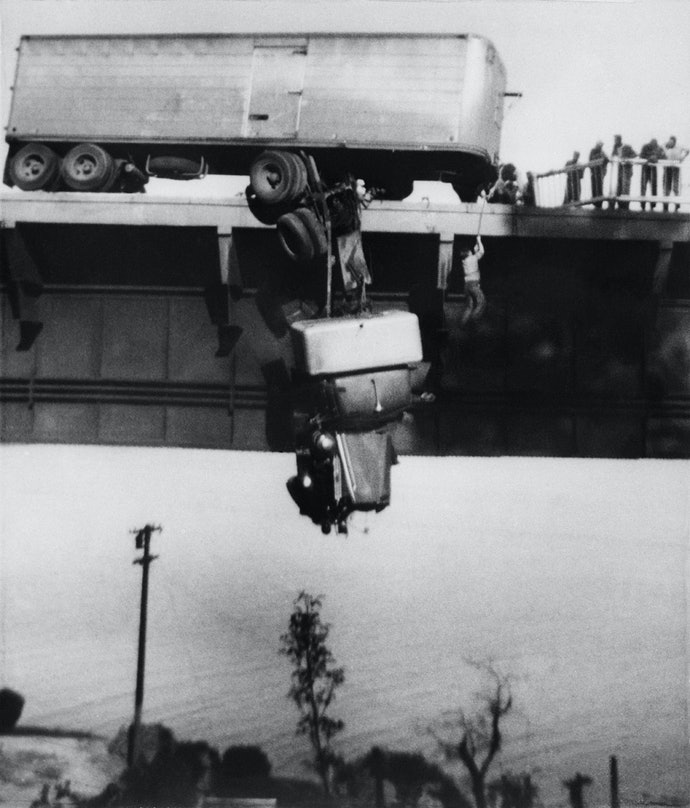 Newspaper editors called this picture ‘Rescue at Redding’. Virginia Shaw wasn’t a professional photographer, but her image won the Pulitzer prize next year. It was a very rare case when an amateur won this prestigious award.
Newspaper editors called this picture ‘Rescue at Redding’. Virginia Shaw wasn’t a professional photographer, but her image won the Pulitzer prize next year. It was a very rare case when an amateur won this prestigious award.
Oldpics puts this picture among rare Pulitzer winning photos that captured an overall positive scene (other images are Homecoming, 1943, Faith and Confidence, 1956, Near Collision at Air Show, 1950). In fact, other Pulitzer winning pictures captured either war or bloody scenes that are both socially important and sad.
The ‘Rescue at Redding’ took place on May 3, 1953, in Lake Shasta. Walter and Virginia Shaw were just fishing when a truck with fruits lost control and crashed into the fence right in front of them. The car was hovering dangerously over the abyss. Two unlucky drivers were still in its cab, without any hope to survive.
As you may guess, Virginia Shaw couldn’t just take out her mobile phone and capture an eye-catching incident. Moreover, taking that image wasn’t her priority. The Shaw family rushed to help the people in the hanging truck. Fortunately, they were not alone on the bridge. Someone took a ship’s rope out of the car, and they threw it to the men in the truck cabin. The engine ignited, and the cabin collapsed into the river right after the drivers got out of their deadly trap.
Stilled moment of ‘Rescue at Redding’
As drivers were getting out, Virginia Shaw suddenly remembered her camera in the car. She ran to her cheap Kodak Brownie with only two frames left. And the film had been overdue for a year. This fact did not stop the woman from taking a picture of the happily resolved incident.
Virginia was happy with her ‘Rescue at Redding’ shot and immediately sent it to the local newspaper. She wanted to get a weekly reward for readers who sent the most interesting picture of the week. Needless to say, Virginia won her ten dollars.
But even more surprising, a year later, her shot won the most prestigious reporters’ prize – the Pulitzer Award. It turned out that Virginia Shaw became the first woman to get the Pulitzer Prize.
Сообщение The story of Rescue at Redding, 1953 появились сначала на Old Pictures.
]]>Сообщение All Pulitzer Prize photos (1942-1967) появились сначала на Old Pictures.
]]> This publication features all photos that won the Pulitzer Prize in the Photography category. It was the very first Pulitzer category to honor outstanding pictures in journalism.
This publication features all photos that won the Pulitzer Prize in the Photography category. It was the very first Pulitzer category to honor outstanding pictures in journalism.
In 1968 the Photography category split on Feature Photography and Spot News Photography (existed till 1999).
Until now, Pulitzer Prize remains the most prestigious journalistic award. Its central concept to honor is the social usefulness of art. Here’s why most of the photos nominated for a Pulitzer Prize are painfully sad and sometimes downright oppressive. But they fulfill their main goal – to inform people about the existing problem, and often help to solve it by drawing public attention to it.
Many of the Pulitzer Prize winning photos correspond with the Top 100 most influential pictures in history.
Some Pulitzer winning statistics
While Literature Pulitzers are strictly allocated to Americans, the Photography section award can go overseas. Although, the major part of Pulitzers went to the Ameican photographers. There’re only four foreigners among the winners of the primal award period (1942-1967).
In most cases, single pictures won the award. But there were several years when sequences of photos won the Pulitzer Prize. In some cases, the jury awarded the whole set but, at the same time picking the main image. That’s what happened in 1957 when honoring Harry’s Trask capture of the Andrea Doria sinking.
Also, there’re was one exceptional year when two photos won the Pulitzer prize together. It was the year of 1944 when Earle L. Bunker received an award for his photo “Homecoming” and Frank Filan was marked for his photo “Tarawa Island.”
We’ve put all Pulitzer winning photos in chronological order.
Also, keep in mind the time lag. Pulitzer is just like Oscar. It honors the photos that were taken a year before.
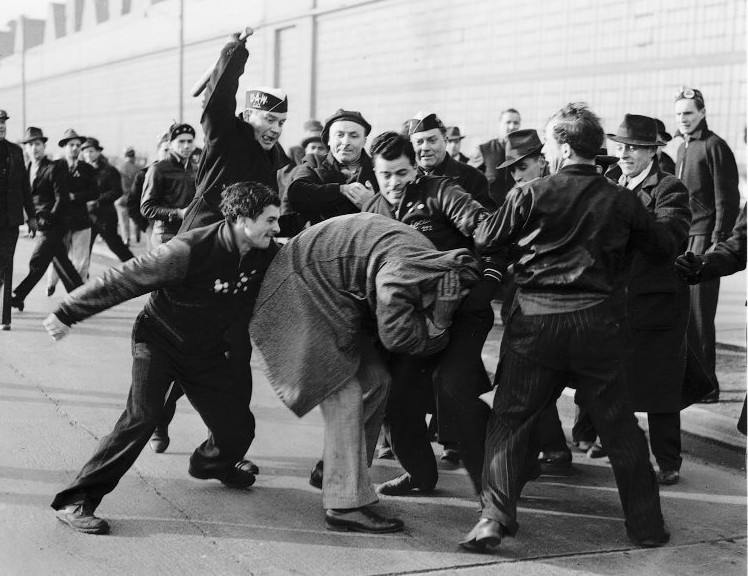
1942. Milton Brooks for his photo entitled, “Ford Strikers Riot.”
‘Ford Strikers Riot’ was the very first photo to win the Pulitzer. The Ford strike in pre-war spring in 1941 had massive media coverage. While some of the factory employees agreed to strike for the rights, very few of them continued to work as usual. At least they tried to do so. Milton Brooks captured the conflict between a worker who wanted to break through the protesters and was beaten. Frankly speaking, this photo looks relatively mild when compared to the future Award nominees.
A full story of the first Pulitzer winning photo.
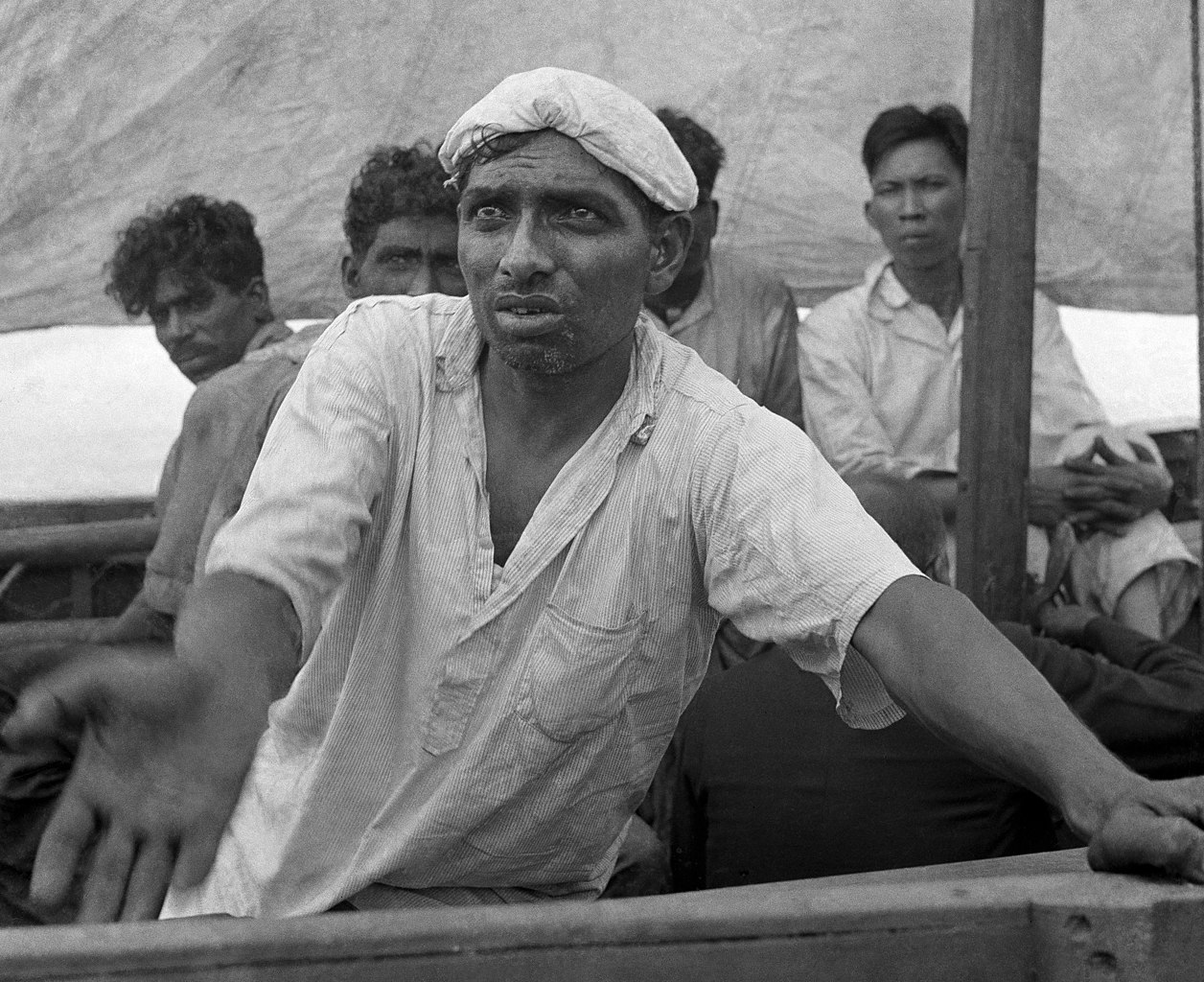
1943. Frank Noel for his photo entitled, “Water!”.
An excellent image of Frank Noel captured the desperate thirst of the shipwrecked survivors. Both, photographer and a hero of the photograph suffered the Japanese torpedo attacks and were looking for survival in the ocean waters. The story behind this photo is just fascinating.
A full story of the ‘Water!’ image.
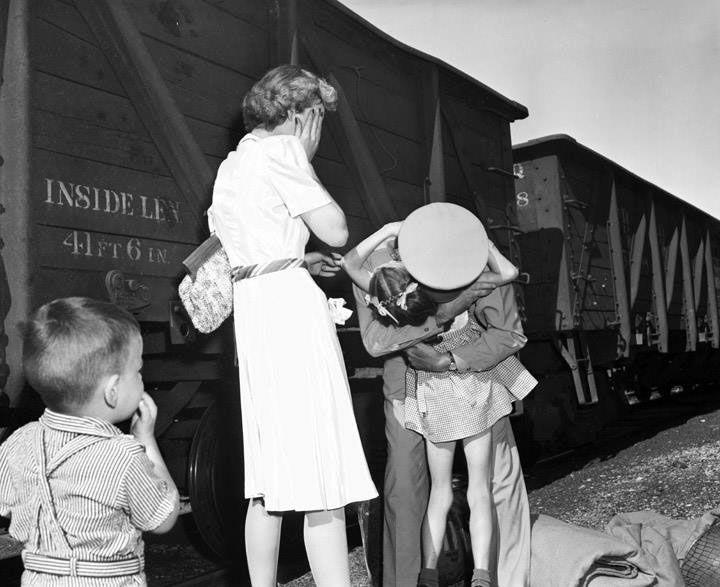
1944. Earle L. Bunker for his photo “Homecoming.”
As we’ve mentioned, there were two Pulitzer Prize winning photos in 1944. ‘Homecoming’ by Earle Bunker was the first one. Photographer captured the heart touching moment when the family’s greeting their dad, who came back from WW2 for a short vacation. And excellent angle and moment that stilled the pure joy.
A full story behind this picture.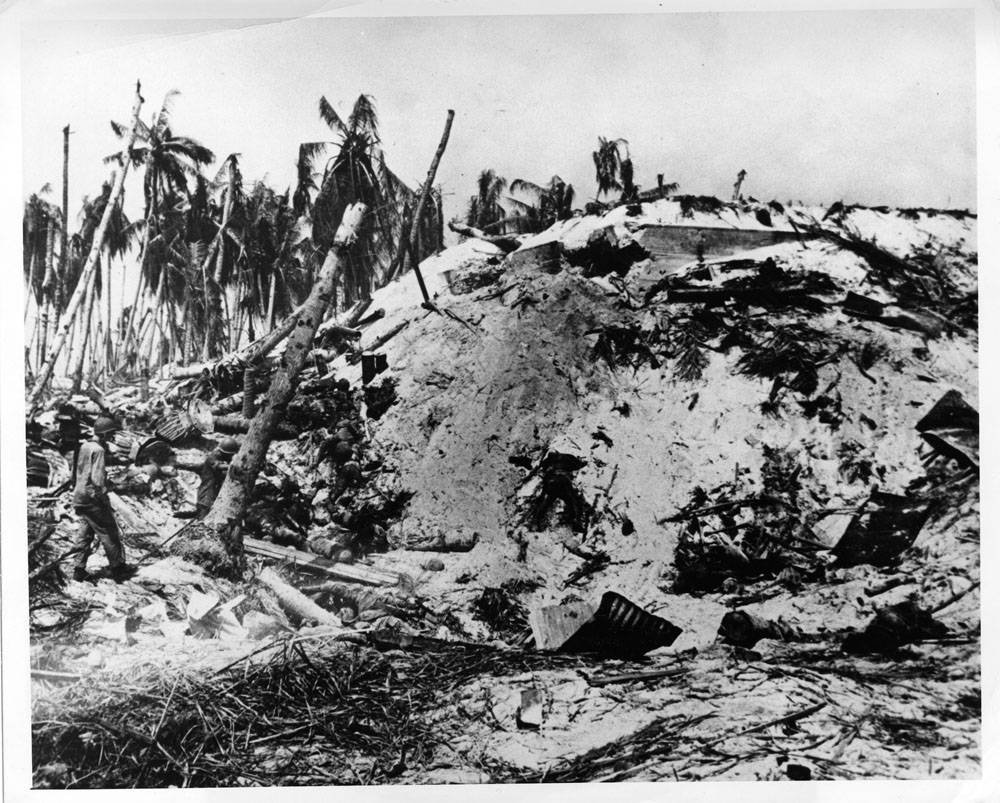
1944. Frank Filan for his photo “Tarawa Island”
The battle of the Tarawa Island (or even Tarawa atoll) was the bloodiest operation of the Pacific Theater of WW2. Frank Filan courageously captured it in the best way possible. While Frank took enough of close-quarters combat pictures, his Pulitzer winning snap wasn’t so dynamic. It photo shows dead Japanese soldiers scattered by the bomb explosion.
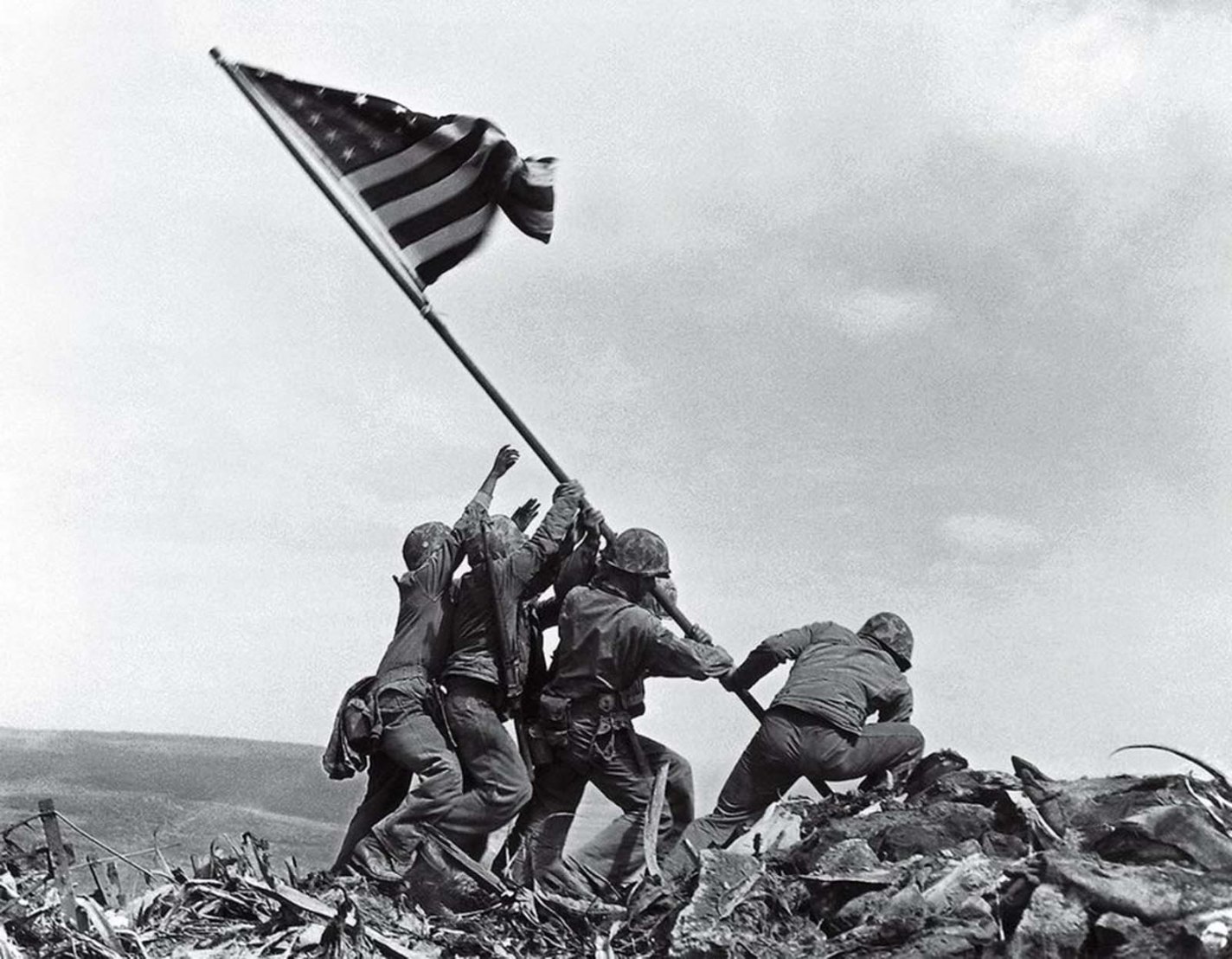
1945. Joe Rosenthal “Marines planting the American flag on Mount Suribachi on Iwo Jima”
The battle of Iwo Jima is a sacred place for American history and war photography. So many glorious camerapeople were there at the same time, but only Joe Rosental was the one who accompanied that group of marines who decided to raise the flag. Eugene Smith was another genius photographer who was there. His WW2 Pacific Battles are also noteworthy. But Joe Rosental was the luckiest photographer who captured one of the greatest Pulitzer Prize winning photos.
Read more about this historical picture.
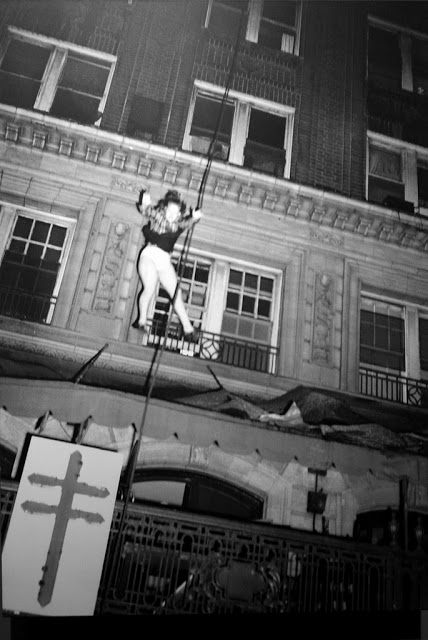
1947. Arnold Hardy for his photo of a woman falling from a burning hotel.
The fire of the Winecoff Hotel killed 119 people on December 7, 1946. This horrible incident captured 280 guests in a burning building. The construction standards of the hotel were completely outdated. There were no fire escapes, fire doors, nor sprinklers.
Firefighters of Atlanta tried to stop the fire desperately. The saved the majority despite the impossible conditions. The inadequate equipment was another reason for the high death toll. The firefighter’s ladders stretched only to the eighth floor. Also, their jumping screens couldn’t hold jumps of more than 70 feet.
Arnold Hardy was an amateur photographer who heard the firefighter’s sirens and decided to follow them for a lucky snapshot. He got a $200 bonus for his picture from the Associated Press.
The woman in his Pulitzer winning photo was Daisy McCumber, a 41-year-old Atlanta clerk. Against all the odds, she unbelievably survived the 115-feet jump.
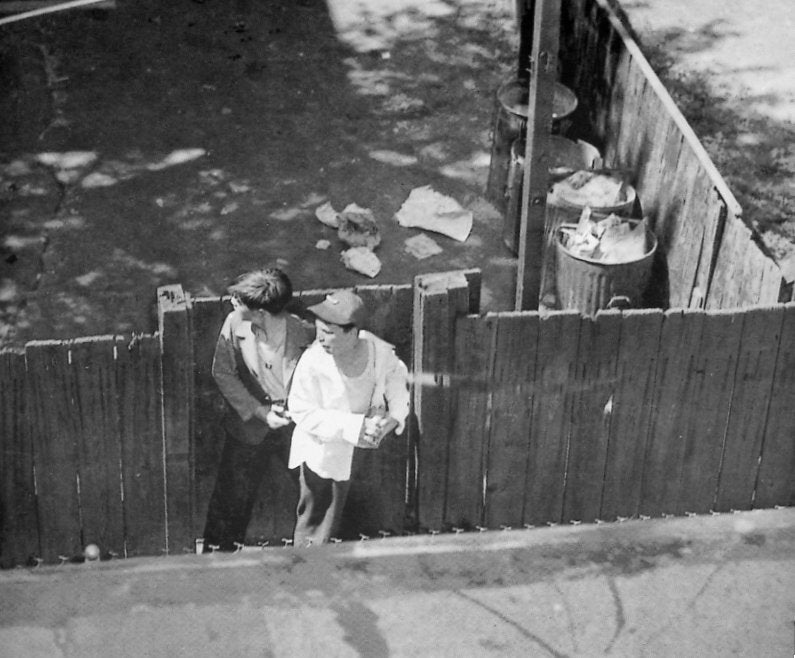
1948. Frank Cushing for his photo “Boy Gunman and Hostage.”
Frank Cushing was on a routine photo assignment of Boston Herald when he occasionally heard an alert coming from the radio of a police car. It was a shooting report, and an officer was injured. Cushing rushed to the crime location.
Ed Bancroft was a boy with a gun. Policemen were asking him about the nearby robbery when he started shooting. He shot an officer and took a hostage, another teenager, Bill Ronan.
Cushing took some long-distance photos, but it too far away. Then the photographer rushed to the house on the opposite side of the street. He convinced a homeowner to let him in and snapped the action scene. “I knew that the gunman noticed me and feared that the kid would shoot me, “Cushing said later, “But I wanted the picture.”
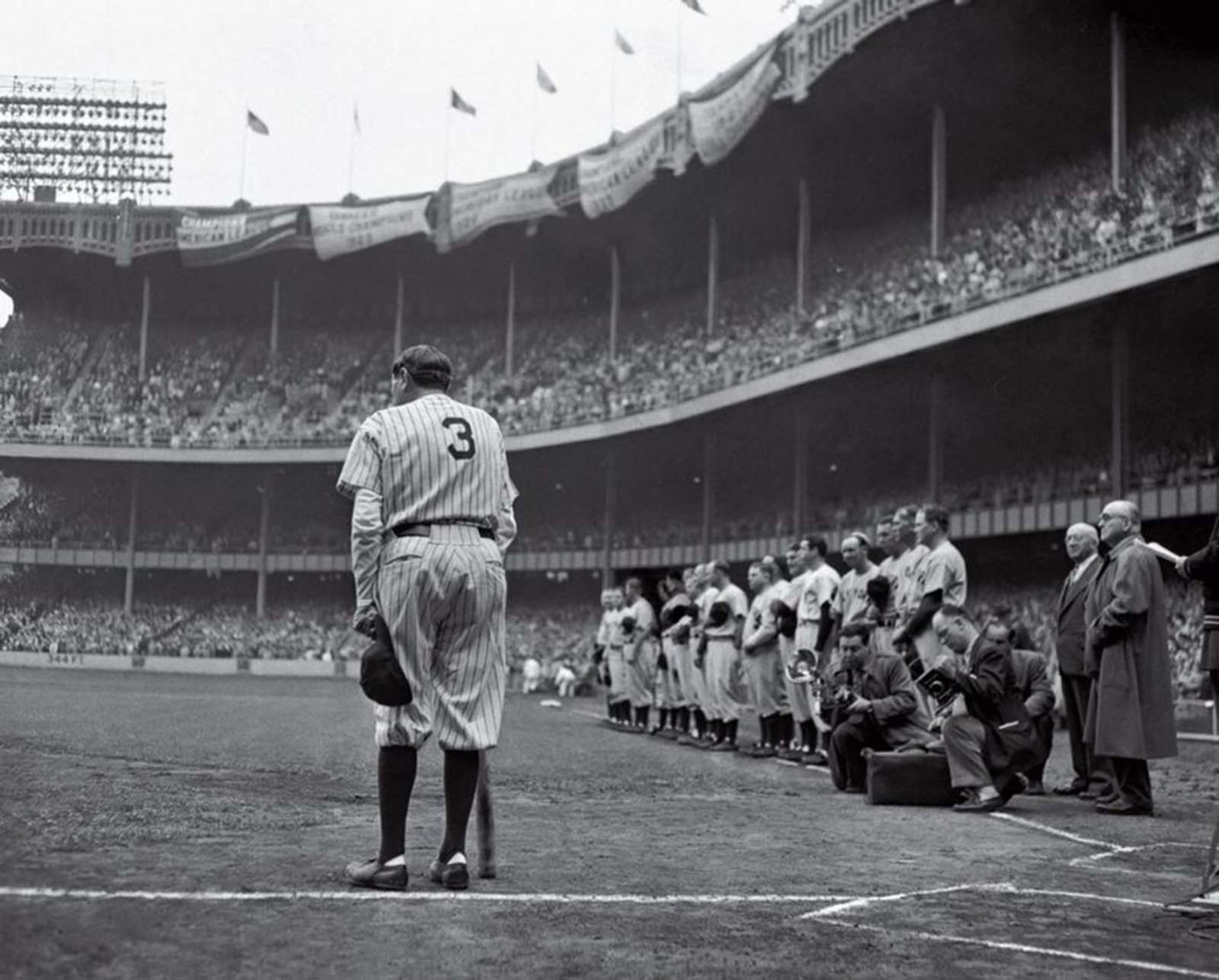
1949. Nathaniel Fein for his photo “Babe Ruth Bows Out.”
This is another photo that hit both the Pulitzer Prize and Top 100 most influential pictures in history. Nathaniel Fein knew that this image would have a decent historical value. Legendary player Babe Ruth had throat cancer, and by that time, he already lost the fight. Ruth visited the 25th-anniversary celebration of the opening of Yankee Stadium in 1948. He came to the stadium to say goodbye to his fans. Ruth died just two months later.
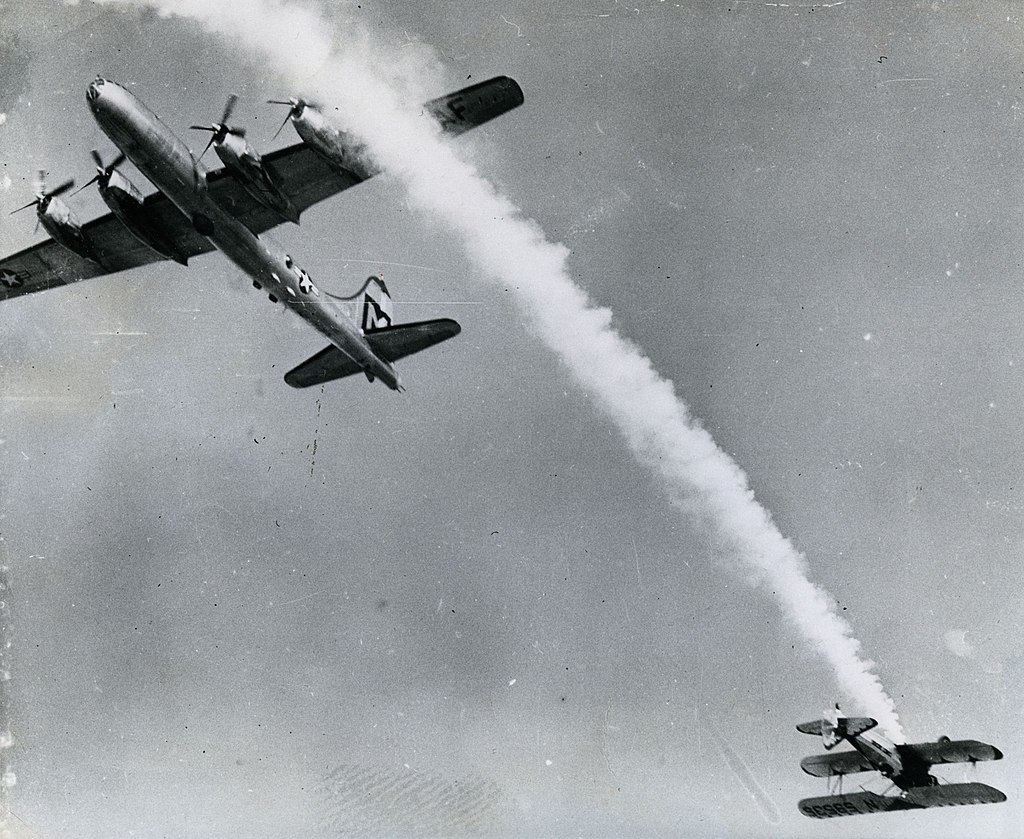
1950. Bill Crouch for his picture, “Near Collision at Air Show.”
The image “Near Collision at Air Show” by Bill Crouch is one of those rare Pulitzer Prize winning photos that captured neither death nor any accident or a disaster. Well, it could be an accident, but Pilot Chet Derby was skilled enough to dodge the B-29 Superfortress. Military airplanes (three of them) were supposed to fly through Derby’s smoke trail. One of the B-29s came in too soon, and Chet’s smoking plane passed within five feet of the deadly collision.
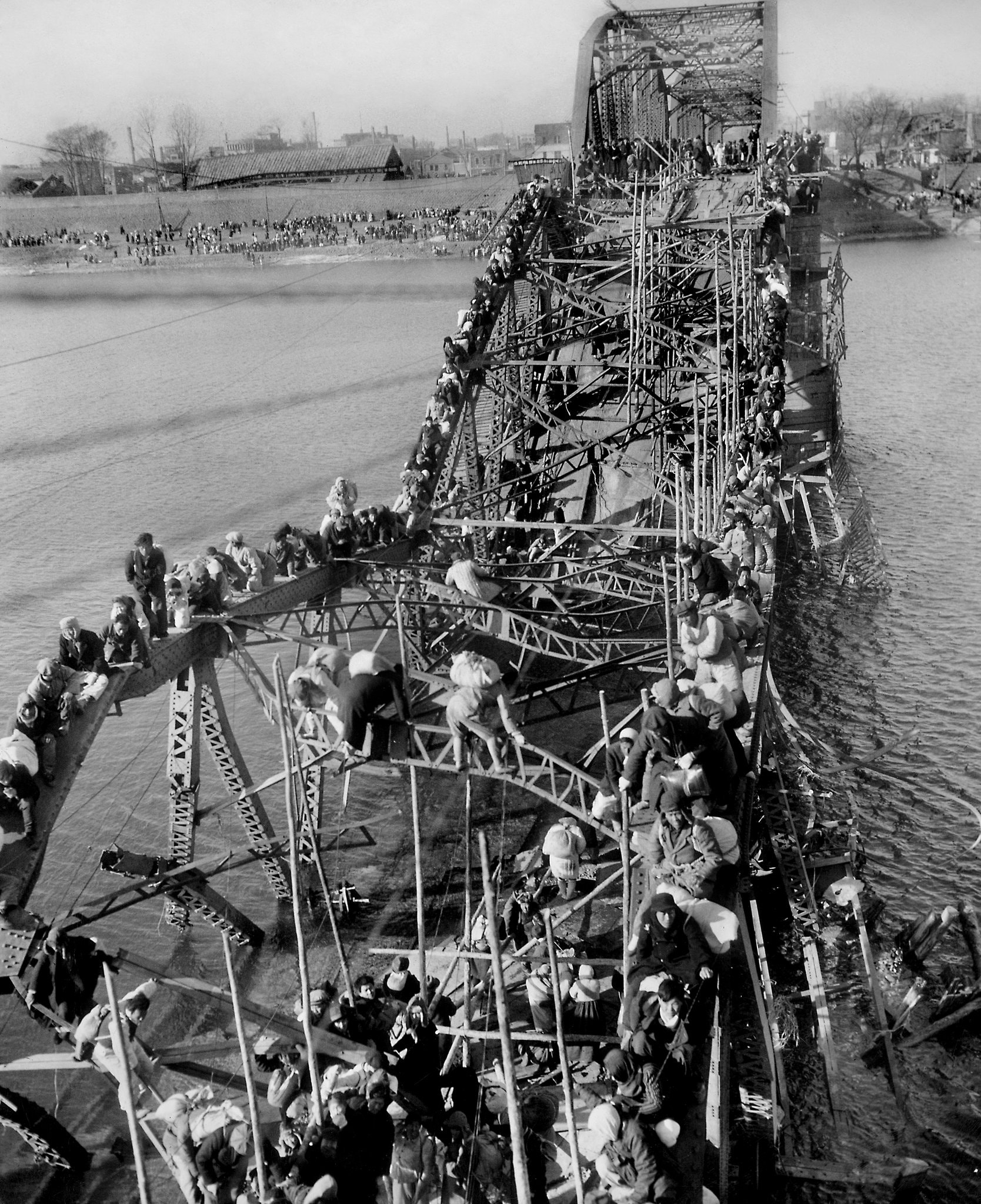
1951. Max Desfor for his photographic coverage of the Korean War.
Max Desfor covered the war in North Korea brilliantly. He captured the rare moments of soldier’s joy together with the pain and suffering of war. In his Pulitzer winning photo, people of Pyongyang and refugees slowly climb over the destroyed bridge. War refugees are directing to the southern bank of the Taedong River. Koreans are trying to escape from the attacking squads of the Chinese army that fought on the North Korea side. Max Desfor captured this photo during the retreat of the American military. He was moving along with the soldiers along the river when noticed, in his words, “a once-reliable way to cross it, recently destroyed by a bomb. Korean refugees were streaming to the southern bank. On these huge beams, they looked like ants … And all this is was going on in absolute silence.”
More excellent photos of the Korean War.
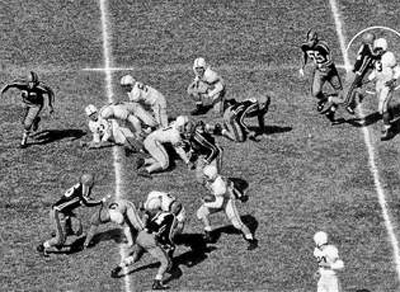
1952. John Robinson and Don Ultang for their sequence of 6 pictures of the Drake-Oklahoma A&M football game.
It was a famous game when Drake player Johnny Bright’s jaw was deliberately broken. The Johnny Bright was an African-American player; the opposing team was all-white. It was the first time that an African-American athlete played on the national level.
Bright’s trauma also emphasized the racial conflicts of that historical period.
This set of four Pulitzer Prize winning photos of the incident captured by photographers John Robinson and Don Ultang perfectly snapped Smith’s jaw-breaking hit. The most important was the fact that everything happened after Bright had passed the ball off. Robinson and Ultang focused on Bright before the game, as everybody was talking that he will become a target on the field.
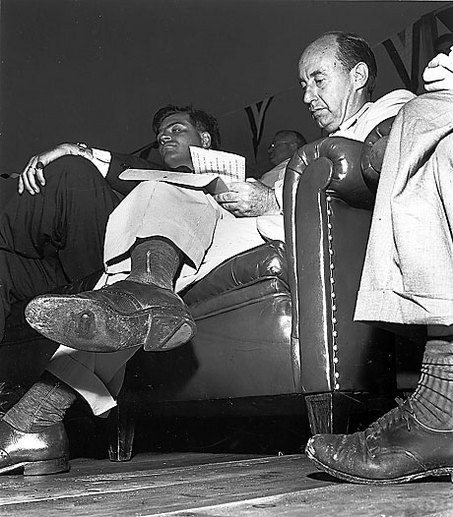 1953. William M. Gallagher for a photo of ex-Governor Adlai E. Stevenson.
1953. William M. Gallagher for a photo of ex-Governor Adlai E. Stevenson.
In the photography world, Bill Gallagher was known for his funny photos. He took this picture of Democratic presidential candidate and Illinois Governor Adlai E. Stevenson (right) and Michigan Gov. G. Mennen Williams on the Labor Day 1952. While getting closer to the podium to record Stevenson’s speech, Gallager detected a hole in Stevenson’s shoe. Gallagher set his focus on six feet, set the lens opening, and removed the flashgun so as not to attract attention. He set the camera on the floor of the platform and snapped a set of the Pulitzer Prize winning photos.

1954. Virginia M. Schau for snapping a rescue at Redding, Calif.
Not all of the Pulitzer Prize photos are made by the professional photographers. A Rescue at Redding is one of them. On May 3, 1953, a 38-year-old housewife from California named Virginia, and her husband Walter were on their way to fish in Shasta Lake. Near Redding, the driver of a fruit truck in front of them lost control and crashed into the railing of the bridge across the Pit River. The couple ran out of the car and saw that the trailer was still balancing on edge, but the cabin with both drivers inside was dangling above the river.
Taking a photograph was not the first thing that the Schau couple did: they immediately rushed to help. Luckily, one of the other witnesses of the crash had a thick sea rope in his trunk, which Walter, together with the other men, threw into the cabin. As soon as the drivers, Bud Overby and Hank Baum, got onto the bridge, the engine of the truck caught fire, and the cabin fell on the rocks from 12 meters.
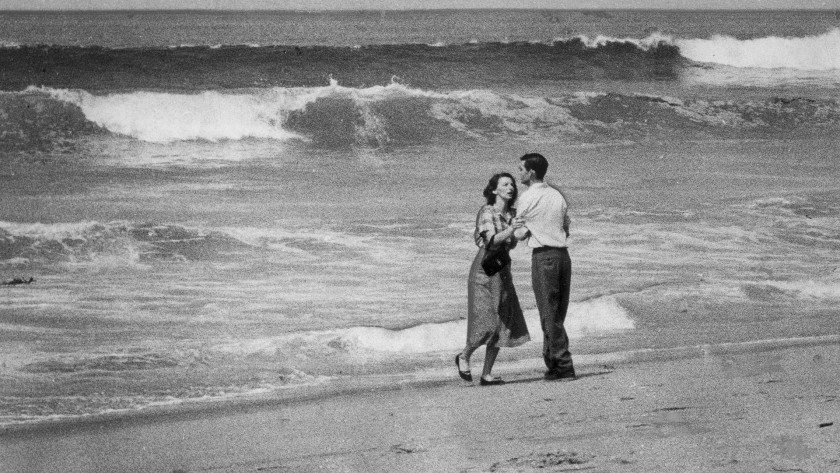
1955. John L. Gaunt for a photo “Tragedy by the Sea”.
This photograph commemorates the tragic incident that took place on April 2, 1954. Photographer John Gaunt lived by the sea. One morning he heard screams on the beach and ran to find out what had happened. He saw a young couple living nearby. They have just discovered the loss of a one and a half-year-old child who fled to the sea and was carried away by the wave. They couldn’t save their baby. The next day, this photo hit the front page of The Times. The picture caused a flurry of criticism. Many considered it unethical to photograph the grief of young parents at such a moment. However, the following year, photography won the Pulitzer Prize. The commission called it “poignant and deeply disturbing.”
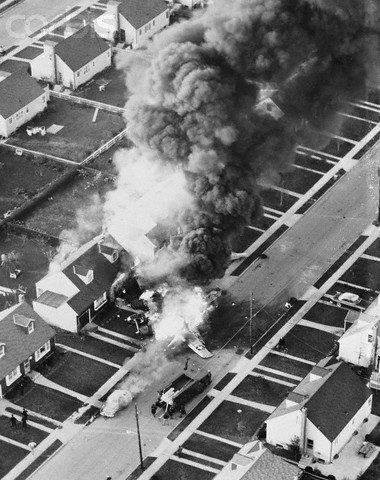
1956 . The staff of New York Daily News for its consistently excellent news picture coverage in 1955.
The best s photo “Bomber Crashes in Street.”
It was the first time when Pulitzer Prize winning photos had collective ownership. The prize went to the staff of the New York Daily News for various outstanding news photo coverage in 1955. The most outstanding sample was this image by George Mattson. He was lucky to fly over a crashed B-26 warplane in Long Island. He took the moment of the firemen squad arrival. Mattson had noticed the smoke and asked his pilot to fly closer to the accident location. He called the editorial staff right after he touched the solid ground. Editor sent more cameras to the plane crash site. Both pilots on the B-26 were killed.
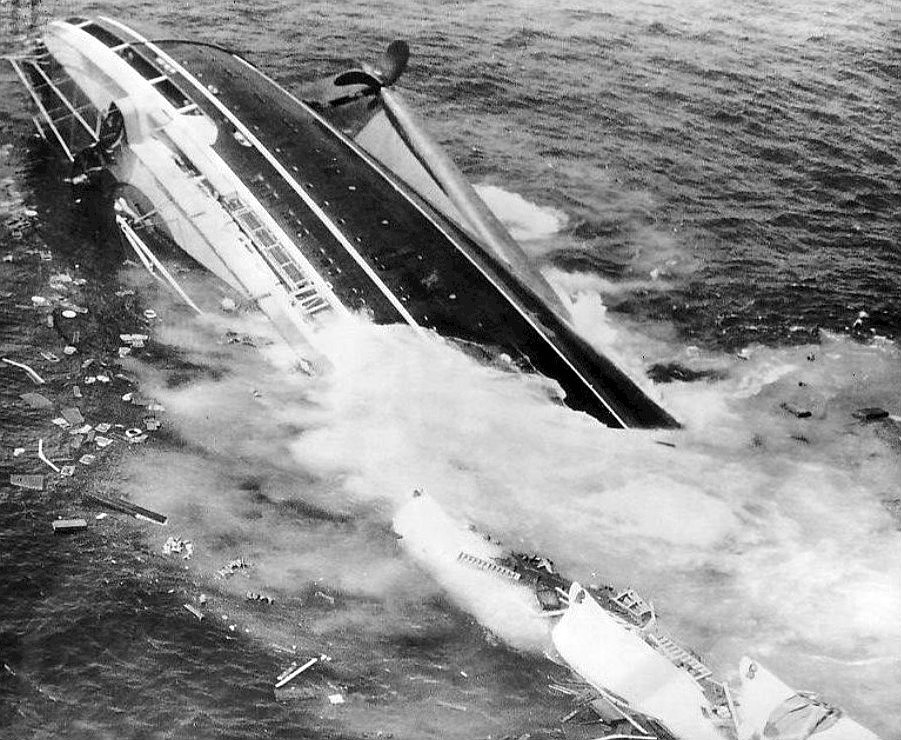
1957. Harry A. Trask for his photographic sequence of the sinking of the liner Andrea Doria.
Harry A. Trask was a lucky photographer at Boston Traveler who captured the final moments of the sinking Andrea Doria ship in 1956. His historical pictures won a Pulitzer Award a year later, in 1957.
The tragic accident happened due to the complicated weather conditions. Two ships collided in a zero vision because of the dense fog.
Trask took an airplane to snap the sinking of the Andrea Doria, a once-gigantic ocean liner. His Pulitzer Prize winning set consisted of four photos. The contest jury picked the one above as a main.
A full story behind the Andrea Doria sinking.
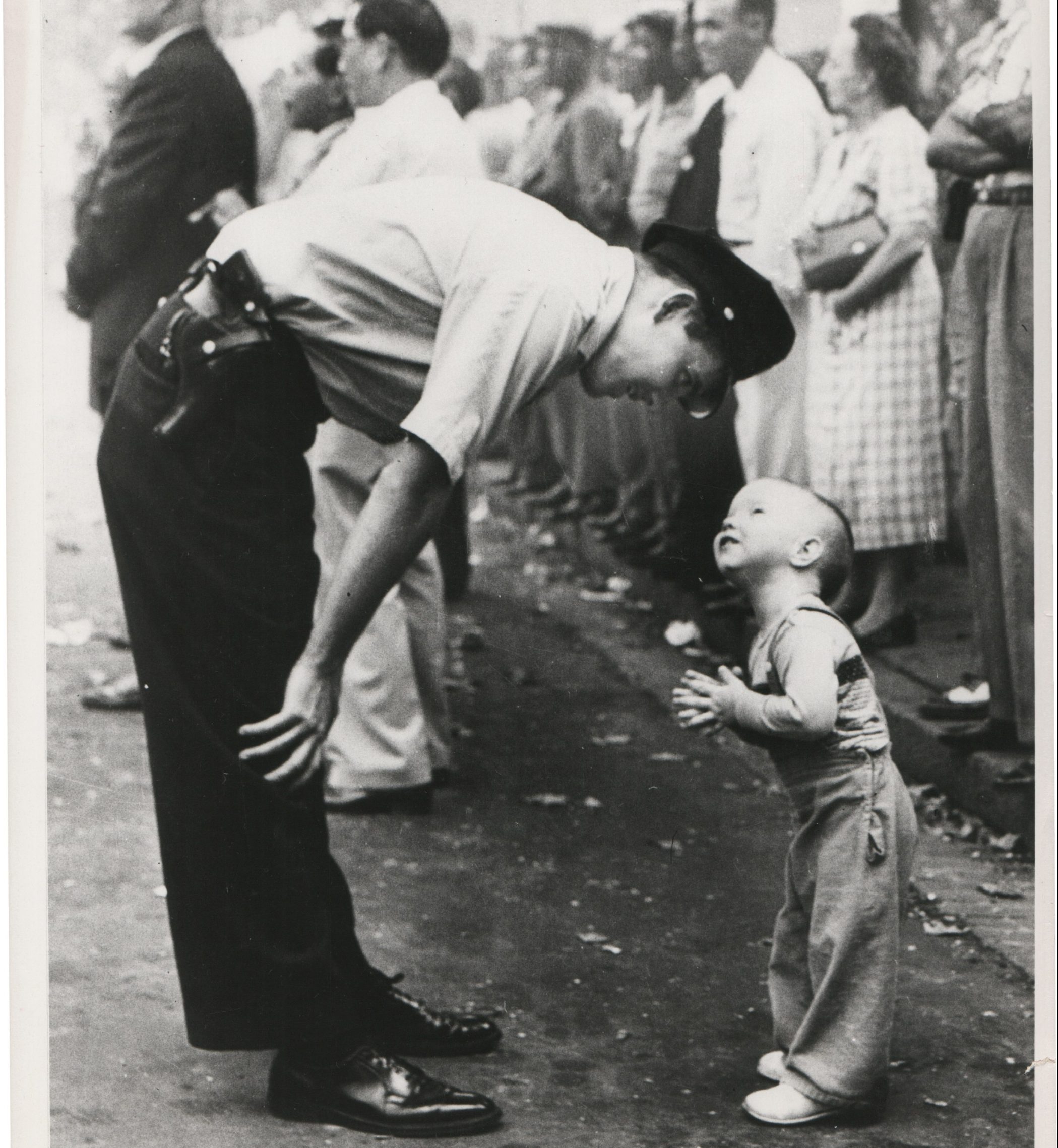
1958. William C. Beall for his photograph “Faith and Confidence”.
William Beall never thought that the routine assignment to cover the Chinese parade would bring one of the Pulitzer Prize photos. He was keeping his eye on the march, trying to find at least one good enough scene. But everything was dull and routine on that day. Suddenly, William noticed a small boy step into the street where the parade was going on. A kid was attracted by a bright and colorful dancing Chinese lion.
A tall young policeman moved towards the boy. He seemed to be inexperienced, and William Beall was curious if the officer will handle this situation. Surprisingly, a young police officer patiently cautioned a kid to step back from the busy street.
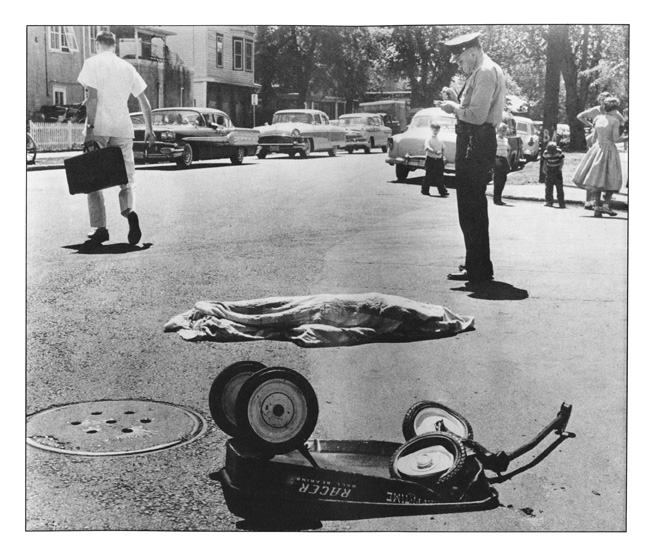
1959. William Seaman for his dramatic photograph of the sudden death of a child in the street.
This winning image of a young boy and a policeman is sad and awful. We cannot imagine that such a picture can hit the publications nowadays.
A blancket covers boy’s lifeless body. His damaged toy is laying nearby.
According to the Pulitzer jury, Seaman captured “a dramatic moment of the sudden death of a child in the street.”
Seaman was hanging around looking for a newsworthy picture for his newspaper. At noticed a young boy, Ralph Leonard Fossum, aged 9. A kid with a red wagon rushed to cross a street when the light was red. Photogrpaher had a son of the same age. Seaman warned a boy to stop, not to pass because of the danger. The young boy fled to the curb, and Seaman continued his search. Moments later photographer heard on the police radio that a young boy had been killed by a garbage truck. He rushed back and found that it was the same boy he had just spoken with.
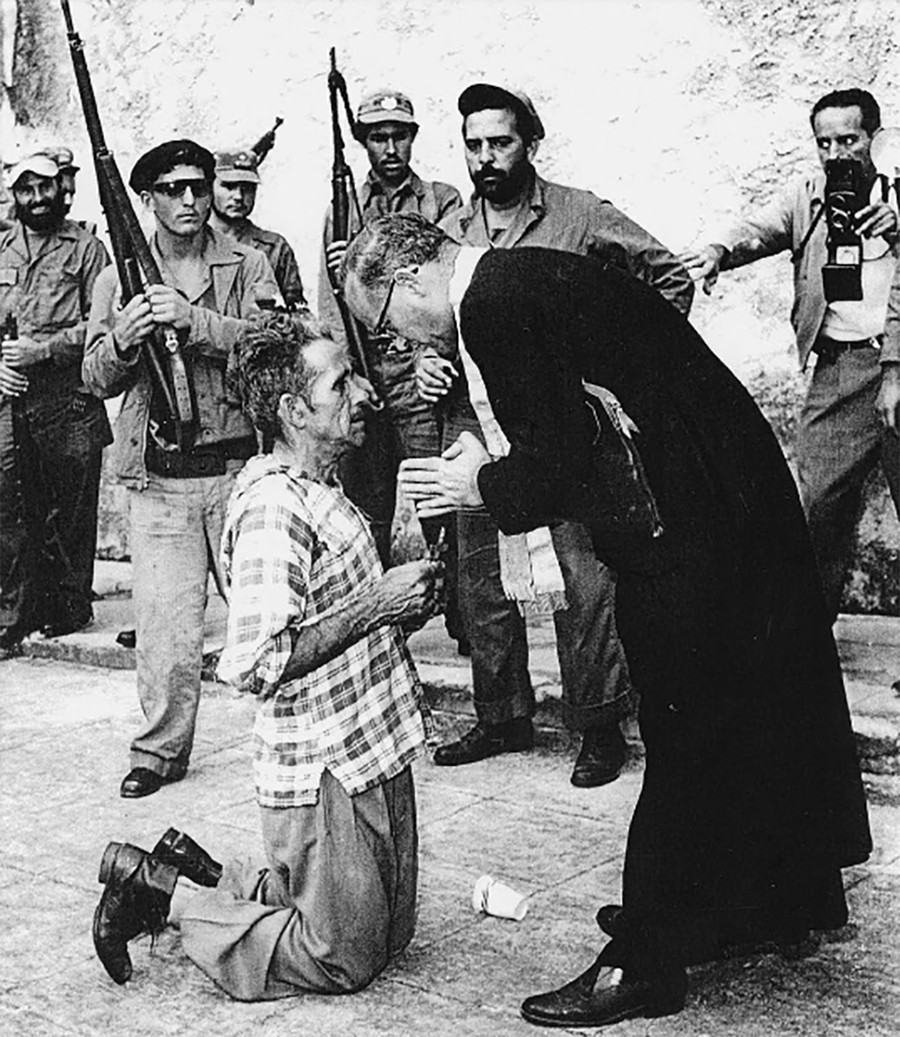 1960. Andrew Lopez. Photographs of a corporal of Dictator Batista’s army.
1960. Andrew Lopez. Photographs of a corporal of Dictator Batista’s army.
In this picture, a former Batista army corporal José Rodríguez receives last rites from a priest at Matanzas, Cuba,1959. Andrew Lopez captured the whole series of Pulitzer Prize photos. The corporal served in the dictator Fulgencio Batista’s army. A Fidel Castro squad executed Rodriguez. The prosecutor, who just proclaimed a death sentence a moment ago, tried to stop Lopez taking photos. He ordered soldiers to bring his films, but Lopez gave them the older ones.
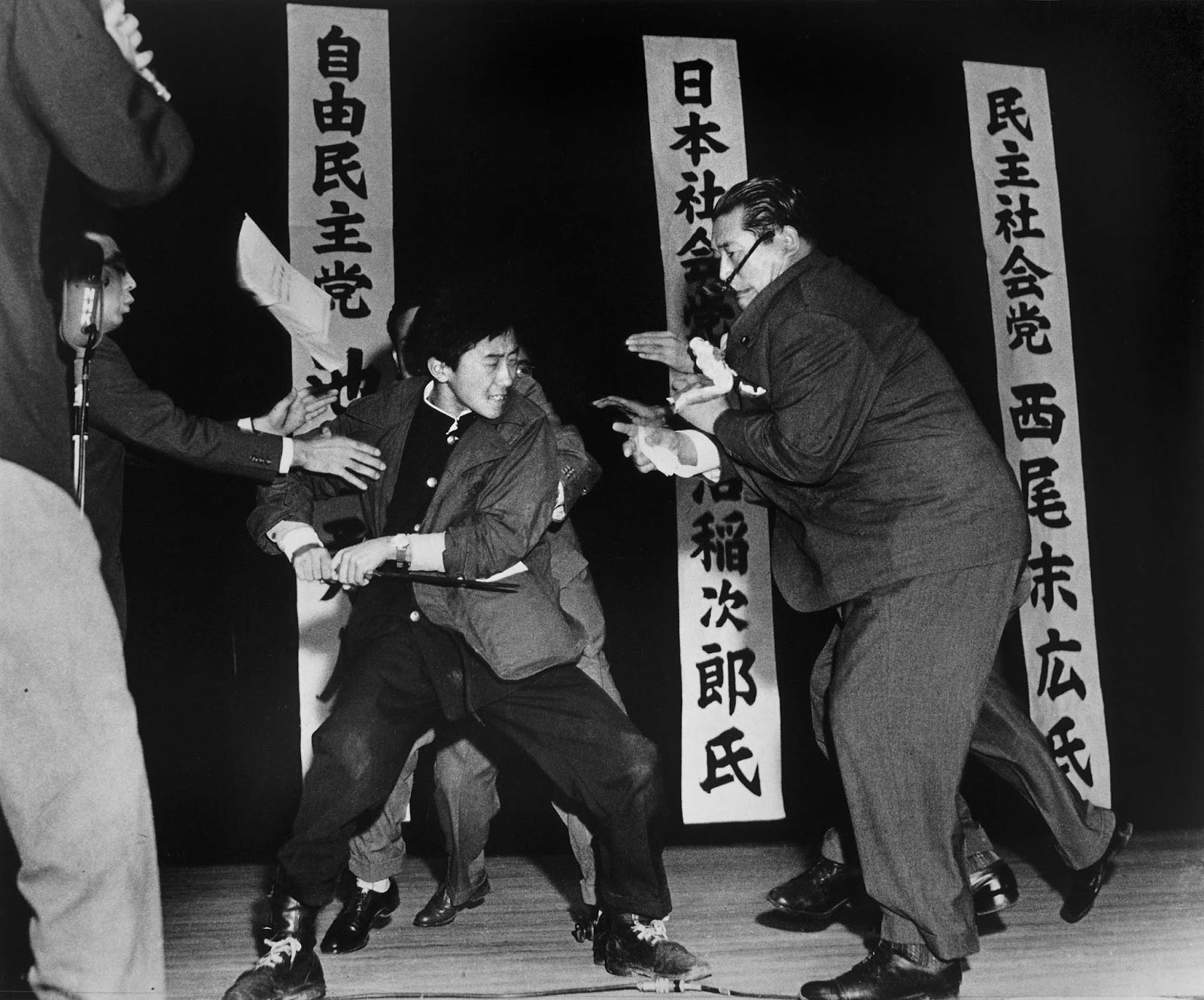
1961. Yasushi Nagao for his photograph, “Tokyo Stabbing.”
On October 12, 1960, the head of the Socialist Party of Japan, Inejiro Asanuma, participated in the pre-election debate in Tokyo. The event went on as usual: noisy and without any incident. But, when the politician was already leaving the building, a young man pounced on Asanuma and stabbed him. Interestingly, he used a short, traditional Japanese wakizashi sword. Here’s why the photographer named this image ‘Tokyo Stabbing.’
A full story behind the Tokyo Stabbing picture.
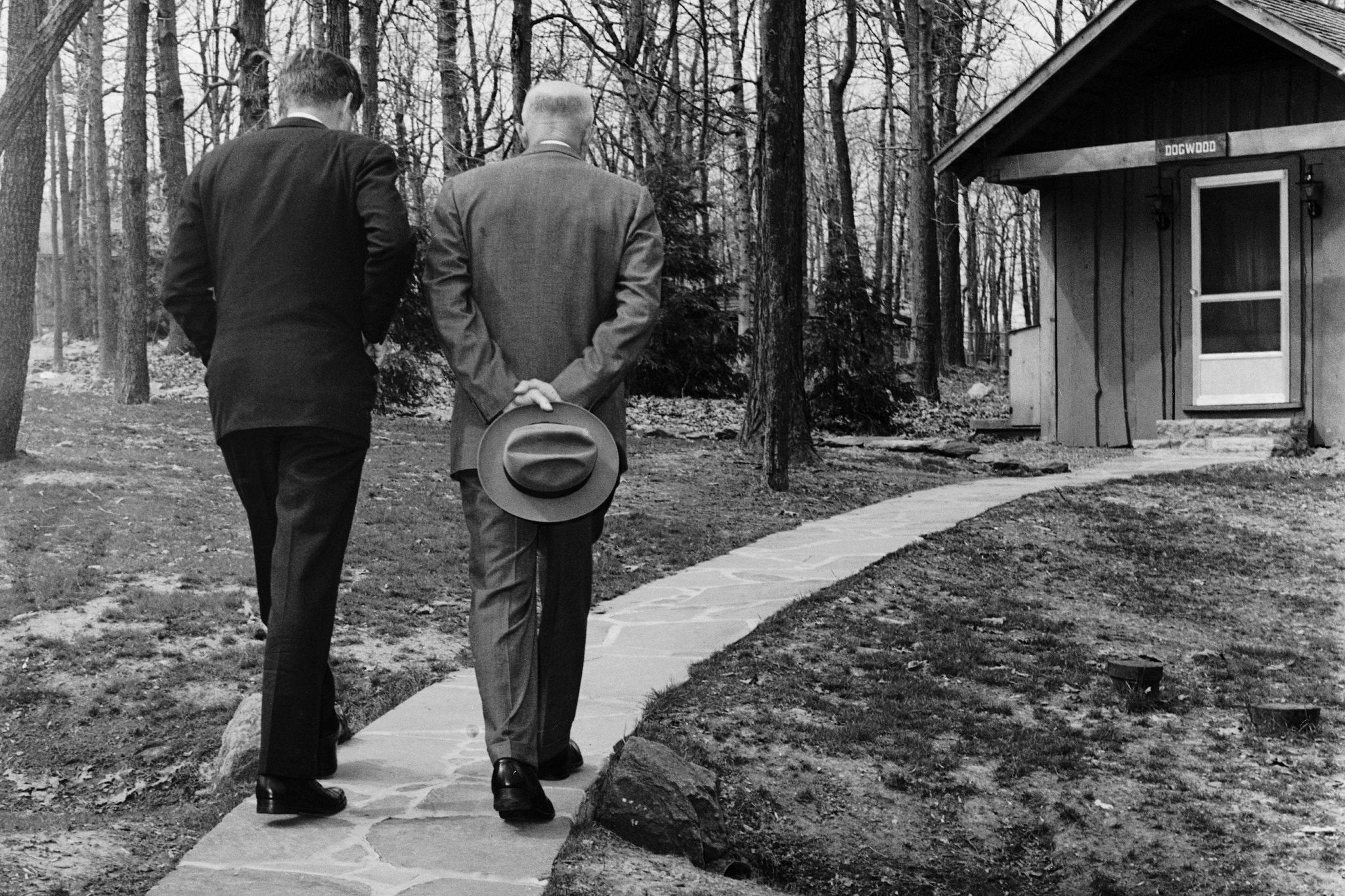
1962. Paul Vathis for the photograph “Serious Steps”.
Paul Vathis captured two presidents Eisenhower and Kennedy during their meeting at Camp David residence in 1961. JFK summoned the former commander Ike to discuss the challenges set by USSR during the early 1960s. The critical point was the failed CIA operation at the Bay of pigs, which couldn’t overthrow Fidel Castro’s regime. Eisenhower advised Kennedy to take some serious steps to show USSR that they have no power in the Western Hemisphere. Here’s how Vathis named this photo ‘Serious steps.’
A full story about the ‘Serius steps’ photo.
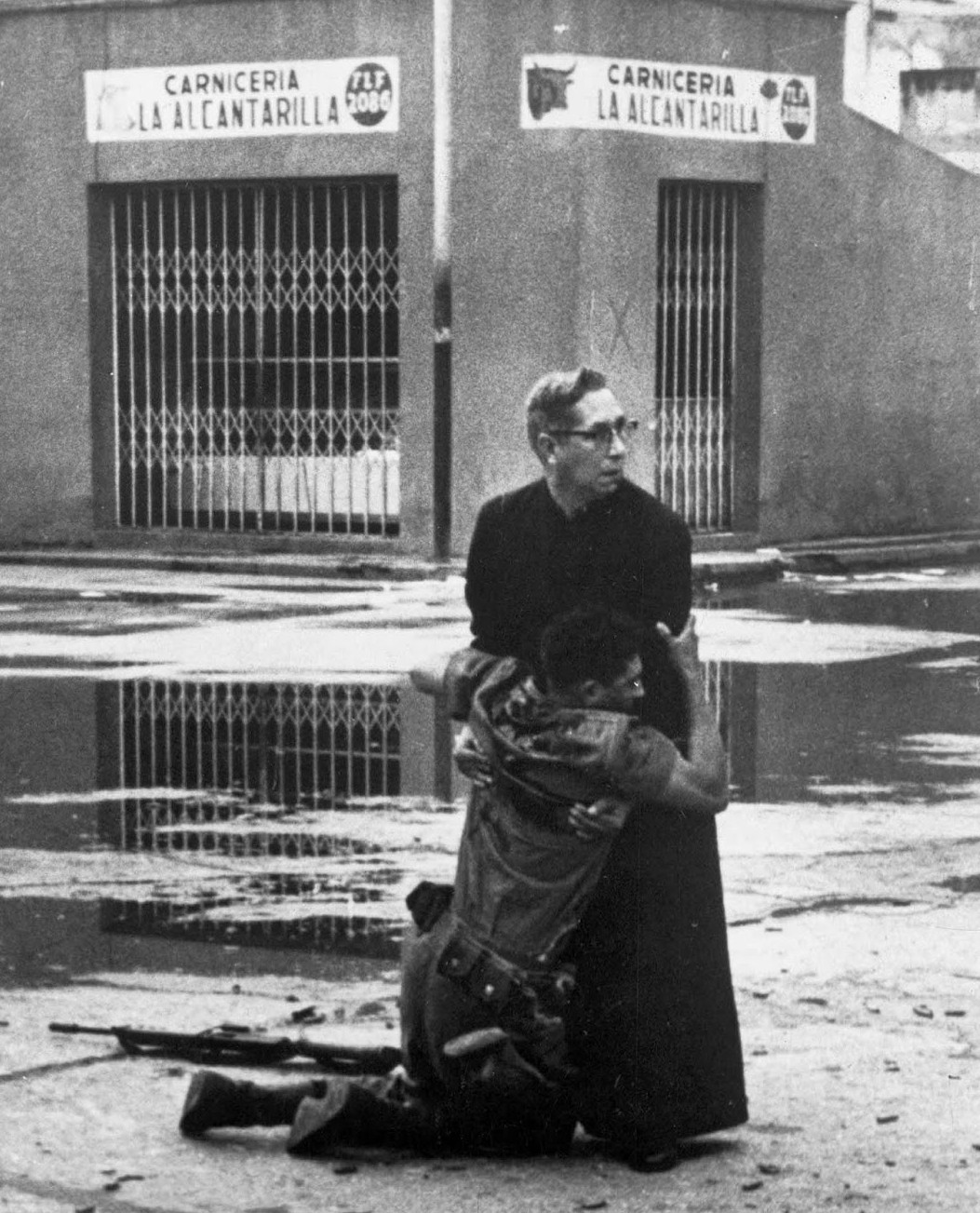
1963. Hector Rondon for his picture of a priest holding a wounded soldier. “Aid From The Padre.”
Hector Rondon Lovera worked as a photo reporter for the Venezuelan newspaper La Republica. He traveled to Puerto Cabello from the capital to cover the military uprising against President Romulo Betancourt. On June 2, 1962, Lovera and his colleague, José Luis Blasco, managed to enter the city and capture the entrance of government tanks to Puerto Cabello. Lovera recalled that he had to take many photographs while lying down on the ground, not to catch a bullet. Later Hector will name his most famous shot of that day, Aid from Padre.
The full story behind the ‘The priest and a dying soldie’ photo.
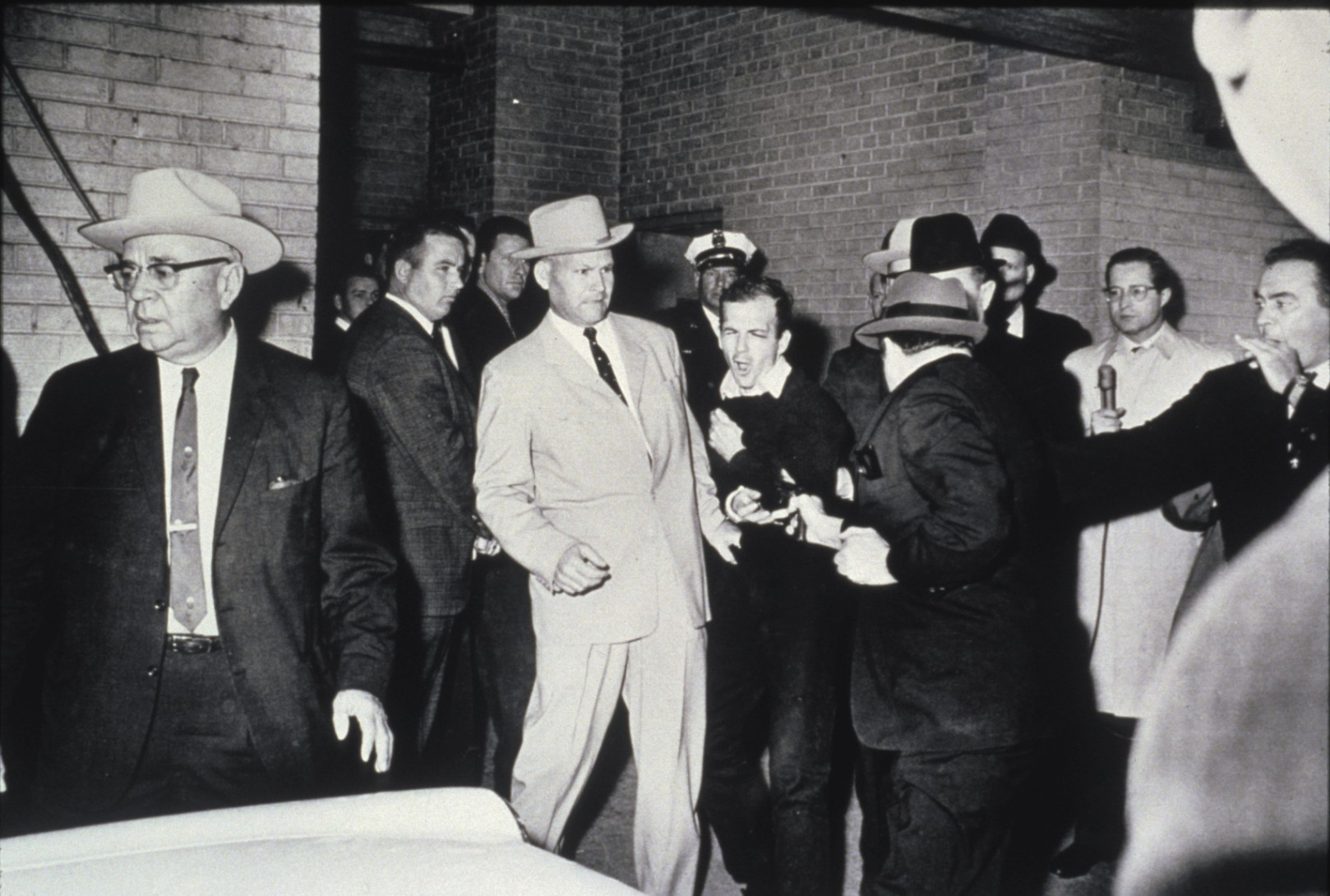
1964. Robert H. Jackson for his photograph’ Murder of Lee Oswald by Jack Ruby’.
Lee Harvey Oswald was under arrest for the assassination of President John F. Kennedy in 1963. Police had to transfer him to the local county jail. Oswald was stepping out from a crowd of reporters and photographers when a nightclub owner Jack Ruby pulled a trigger of his Colt Cobra and shot him dead.
Ruby’s motives for killing Oswald were not clear.
There were plenty of cameras that also captured the moment. But Robert H. Jackson had the best angle. Pulitzer jury noted that the image captured “the cold-blooded determination of the killer, the painful gasp of the handcuffed victim, and the confuse of helplessness on the face of a policeman.”
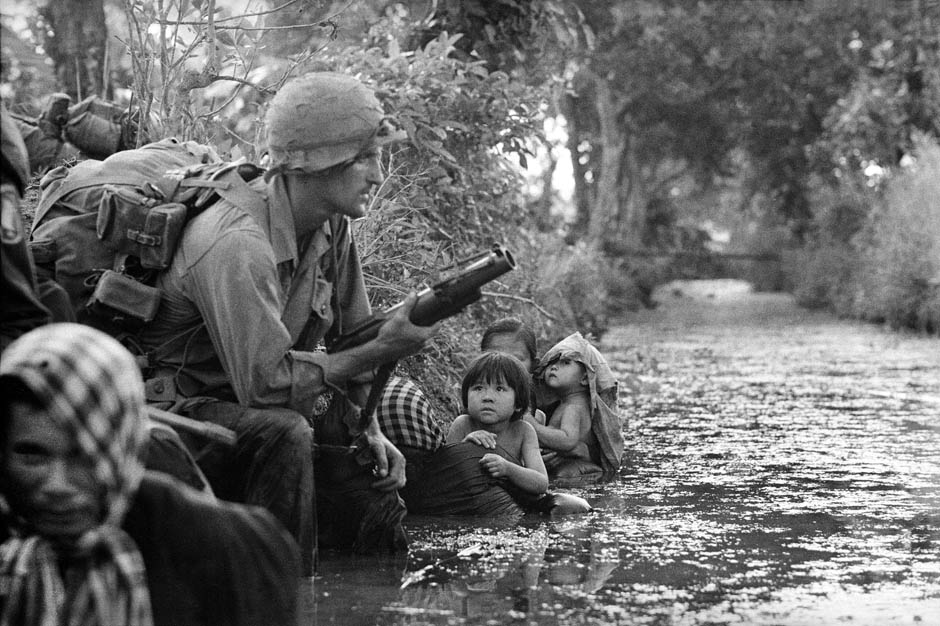
1965. Horst Faas for his combat photography of the war in South Vietnam.
While taking his Pulitzer winning photos, Faas didn’t try to show US soldiers as heroes all the time. And here’s why some officers didn’t like his photography. “This is a terrible photo,” complained one of the commanders. “I don’t want these pictures of my squad. Soldiers look sleepy and tired. They are in a fighting squad.”
Faas tried to explain that their exhaustion reflects their combat experience; six months later, this photograph became so popular that the same commander invited Faasa once more to take new pictures of his platoon.
More of excellent Vietnam photography by Horst Faas.
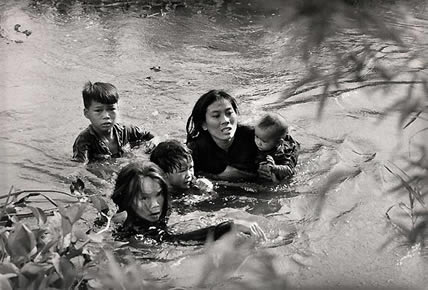
1966. Kyoichi Sawada for Combat photography of the war in Vietnam.
Kyoichi Sawada started his photography career in 1961, working at the Tokyo branch of the United Press news agency. Later he became the chief photo editor of the office. But, the young photographer wanted to become famous. He followed the famous expression that “no one gets glory in the war, except for generals and photographers.” This is why he went to Vietnam in February 1965. In several months Kyoichi Sawada took several photos of women and children fleeing from the bombing, which won him both the Pulitzer Prize and the World Press Photo award.
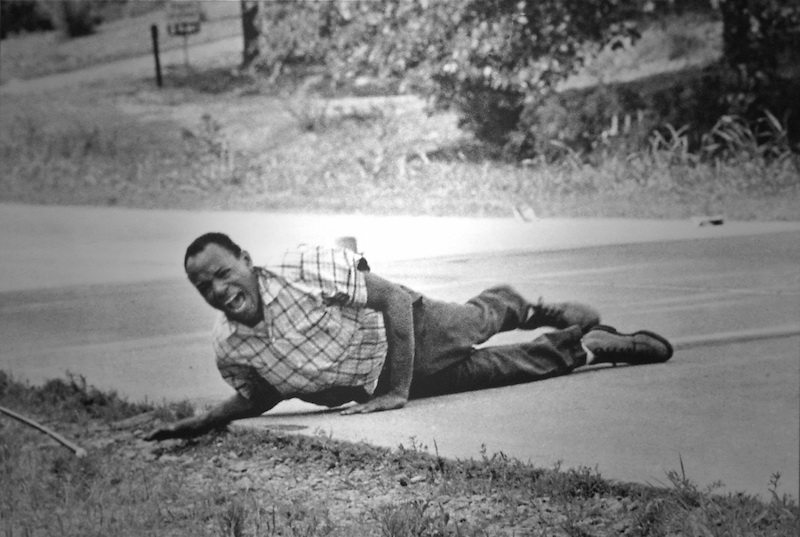
1967. Jack R. Thornell for ‘The shooting of James Meredith.’
The Civil Rights Movement in the United States passed through some hot years in the 1960s. Despite the fact the segregation left formally in the past, Afro-Americans had to fight to fill their rights with the real sense. James Meredith was one of the most influential civil rights movement figures. A Tennessee-born man gained popularity after entering the University of Mississippi.
Jack Thornell was an Associated Press intern when he received an assignment to cover this Civil Rights March. 26-year-old caught a lady luck tail when a senior photographer left the march to buy soda. Thornell was the only reporter who captured the dramatic moment when James Meredith was shot. After the sniper started to pull the trigger, Thornell immediately picked his camera and pressed the shutter.
Сообщение All Pulitzer Prize photos (1942-1967) появились сначала на Old Pictures.
]]>Сообщение The photo of the shot James Meredith, 1967 появились сначала на Old Pictures.
]]> This picture of the shot civil rights activist James Meredith by Jack Thornell was the last to win the Pulitzer award in the Photography section in 1967. Afterward, this nomination split on Feature Photography and Spot News Photography (existed till 1999).
This picture of the shot civil rights activist James Meredith by Jack Thornell was the last to win the Pulitzer award in the Photography section in 1967. Afterward, this nomination split on Feature Photography and Spot News Photography (existed till 1999).
Read more: All Pulitzer Winning Photos (1942-1967)
James Meredith and the civil rights movement
The Civil Rights Movement in the United States passed through some hot years in the 1960s. Despite the fact the segregation left formally in the past, Afro-Americans had to fight to fill their rights with the real sense. James Meredith was one of the most influential civil rights movement figures. A Tennessee-born man gained popularity after entering the University of Mississippi. Not the best place to study for a black guy in the 1960s. James Meredith was the first Afro-American who dared to set his foot into this Univesity. He was kind of following the way of Ruby Bridges, who attended the white school in Southern state during this period.
The dangerous march of 1966
In 1966, he orchestrated a massive civil rights event called “March Against Fear.” James Meredith intended to cover 220 miles from Memphis, Tennessee, to Jackson, Mississippi, to demonstrate local Afro-Americans that they should not fear harsh white social conditions.
Three police cars, news reporters, a few buddies of James, and FBI agents escorted this march was escorted. Nonetheless, Aubrey James Norvell shot James Meredith on day two. Overall, a sniper shot him three times. Norvell wounded activist’s shoulder, chest, and leg. In the photo, shot James Meredith hugs the ground looking for cover. He screamed out, “Oh my God!”.
Capturing the shot
Jack Thornell was an Associated Press intern when he received an assignment to cover this Civil Rights March. 26-year-old caught a lady luck tail when a senior photographer left the march to buy soda. Thornell was the only reporter who captured the dramatic moment when James Meredith was shot. After the sniper started to pull the trigger, Thornell immediately picked his camera and pressed the shutter.
Several prominent civil rights figures, including Dr. Martin Luther King Jr, visited James Meredith the next day after the shot incident.
Сообщение The photo of the shot James Meredith, 1967 появились сначала на Old Pictures.
]]>Сообщение Faith and confidence: Pulitzer winning photography, 1958 появились сначала на Old Pictures.
]]> ‘Faith and confidence’ belongs to those Pulitzer-winning photography that didn’t capture a violent, dramatic, or historical event. It’s just a cute, heart-touching picture that captured the perfect moment.
‘Faith and confidence’ belongs to those Pulitzer-winning photography that didn’t capture a violent, dramatic, or historical event. It’s just a cute, heart-touching picture that captured the perfect moment.
The camera angle is excellent; the scene is self-speaking and needs no translation to any language. William Beall stilled a moment when a policeman is patiently talking to a two-year-old boy, preventing him from crossing a street during a crowded public event.
Read more: All Pulitzer Winning Photos (1942-1967)
William Beall was working as a photo reporter at the Washington Daily, when he was assigned to bring some photos from the Chinese Merchants Association parade on September 10, 1957. It was a kind of event which never could produce a bright, noteworthy image. Just a regular reporter’s assignment, which takes thirty minutes or so to accomplish. Who could imagine that William Beall will capture one of the world-known pictures and win Pulitzer a year later?
The moment of Faith and confidence
Beall remembered that he was keeping his eye on the parade, trying to find at least one good enough scene. But everything was dull and routine on that day. Suddenly, William noticed a small boy step into the street where the parade was going on. A kid was attracted by a bright and colorful dancing Chinese lion.
A tall young policeman moved towards the boy. He seemed to be inexperienced, and William Beall was curious if the officer will handle this situation. Surprisingly, a young police officer patiently cautioned a kid to step back from the busy street. Beall liked what he saw and called this image ‘Faith and confidence.’ “I suddenly noticed the scene, turned, waited for a while, and pressed the shutter.” The result was a moment of childhood innocence stilled in time.
The name of the policemen was Maurice Cullinane. Years later, he became a Chief of Police of Washington DC.
Almost famous William Beall.
Interestingly, William Beall was on Iwo Jima during WWII action. He served as a photo reporter at the time when Joe Rosenthal captured his famous flag-raising photo. Beall wore the same marine photography outfit as Rosenthal, but unluckily he followed the different squad on that day and appeared on the other side of the island.
Сообщение Faith and confidence: Pulitzer winning photography, 1958 появились сначала на Old Pictures.
]]>Сообщение Pulitzer prize photography: ‘Homecoming’ by Earle Bunker появились сначала на Old Pictures.
]]> Earle Bunker found himself among Pulitzer Prize winners in 1944 for his photo ‘Homecoming’. Here’s an interesting one: 1944 was a special year in the Pulitzer award history. Two photographers received the prize in the Photography category that year. Usually, there was only one winner. The second winning picture was Frank Filan’s “Tarawa Island.”
Earle Bunker found himself among Pulitzer Prize winners in 1944 for his photo ‘Homecoming’. Here’s an interesting one: 1944 was a special year in the Pulitzer award history. Two photographers received the prize in the Photography category that year. Usually, there was only one winner. The second winning picture was Frank Filan’s “Tarawa Island.”
Read more: All Pulitzer Winning Photos (1942-1967)
Before winning ‘Pulitzer’, ‘Homecoming’ image originally appeared in The Omaha World-Herald’s. Bunker captured the Homecoming scene in Villisca, Iowa, on July 15, 1943.
The scene is extremely heart touching and it’s the oldest con in the book. Lieutenant Robert Moore is returning home for a short vacation during his army service. His wife, Dorothy Dee Moore, and daughter Nancy, 7, are greeting their daddy. A boy standing left is Moore’s nephew Michael Croxdale.
‘Homecoming’, a classic scene of joy
The joy of meeting coming back soldiers is nothing new, but it always a source of positive emotions. Maybe it was a reason behind the Pulitzer Jury decision in 1944. People of the US demanded some positive news during grim WW2 days.
Earle Bunker’s ‘Homecoming’ photo shares the same emotions as ‘V-J on Time Square’, that celebrates the end of the war. In the case of ‘Homecoming’, it’s only a few-day pause in service.
Earl Bunker and Frank Filan joined a company of Frank Noel and Milton E. Brooks who received a Pulitzer Prize in Photography category before.
It turns out that the Pacific Theater of WW2 started, carried on, and ended up with Pulitzer-winning photography. While ‘Water!’ image captured the first weeks of conflict. The ‘Homecoming’ and ‘Tarawa Island’ images capture the different aspects of the mid-war years. The setting flag on Iwo Jima symbolizes the end of WW2.
Check out the stories of other outstanding Pulitzer winning photography:
The Saigon Execution by Eddie Adams
A bloody execution during the Iranian Revolution
Сообщение Pulitzer prize photography: ‘Homecoming’ by Earle Bunker появились сначала на Old Pictures.
]]>Сообщение Pulitzer photography: The priest and the dying soldier, 1962 появились сначала на Old Pictures.
]]>
Aid from padre, 1962
A photograph of The priest and the dying soldier during an uprising in Venezuela won the 1963 Pulitzer Prize for Best Photo of the Year. Desperate photographer, Héctor Rondon Lovera, definitely didn’t stage this photo. There’s no doubt that he risked his life under a hail of bullets while capturing this historical image. This photo reminds of the best revolutionary photography of Susan Meiselas, the bloody reports from the Iranian Revolutions, and, of course, another Pulitzer-winning photo: The last stand of President Allende.
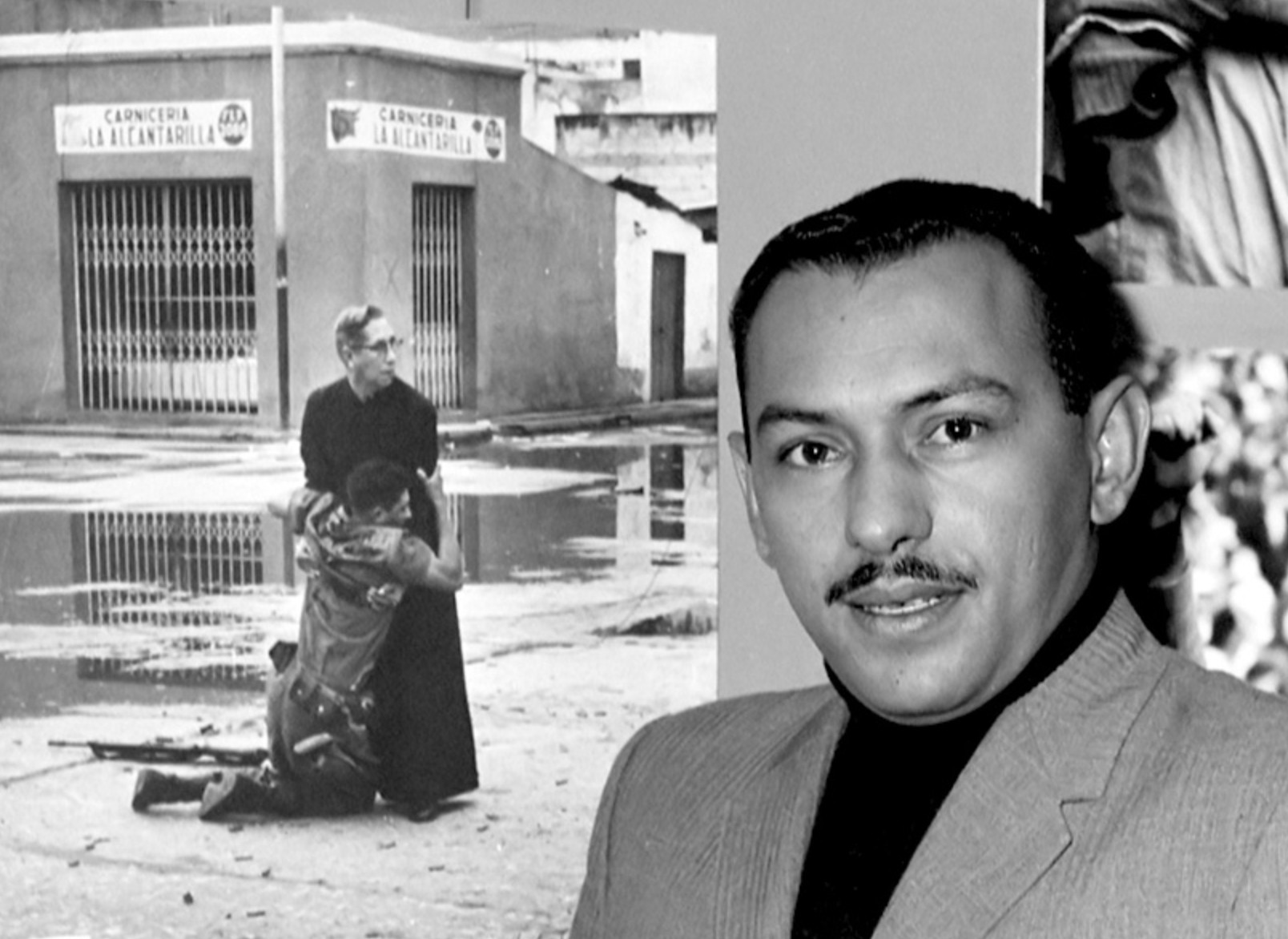
Hector Rondon Lovera and his famous photo
A brave cameraman
Hector Rondon Lovera worked as a photo reporter for the Venezuelan newspaper La Republica. He traveled to Puerto Cabello from the capital to cover the military uprising against President Romulo Betancourt. On June 2, 1962, Lovera and his colleague, José Luis Blasco, managed to enter the city and capture the entrance of government tanks to Puerto Cabello. Lovera recalled that he had to take many photographs while lying down on the ground, not to catch a bullet. Later Hector will name his most famous shot of that day, Aid from Padre.
Read more: All Pulitzer Winning Photos (1942-1967)
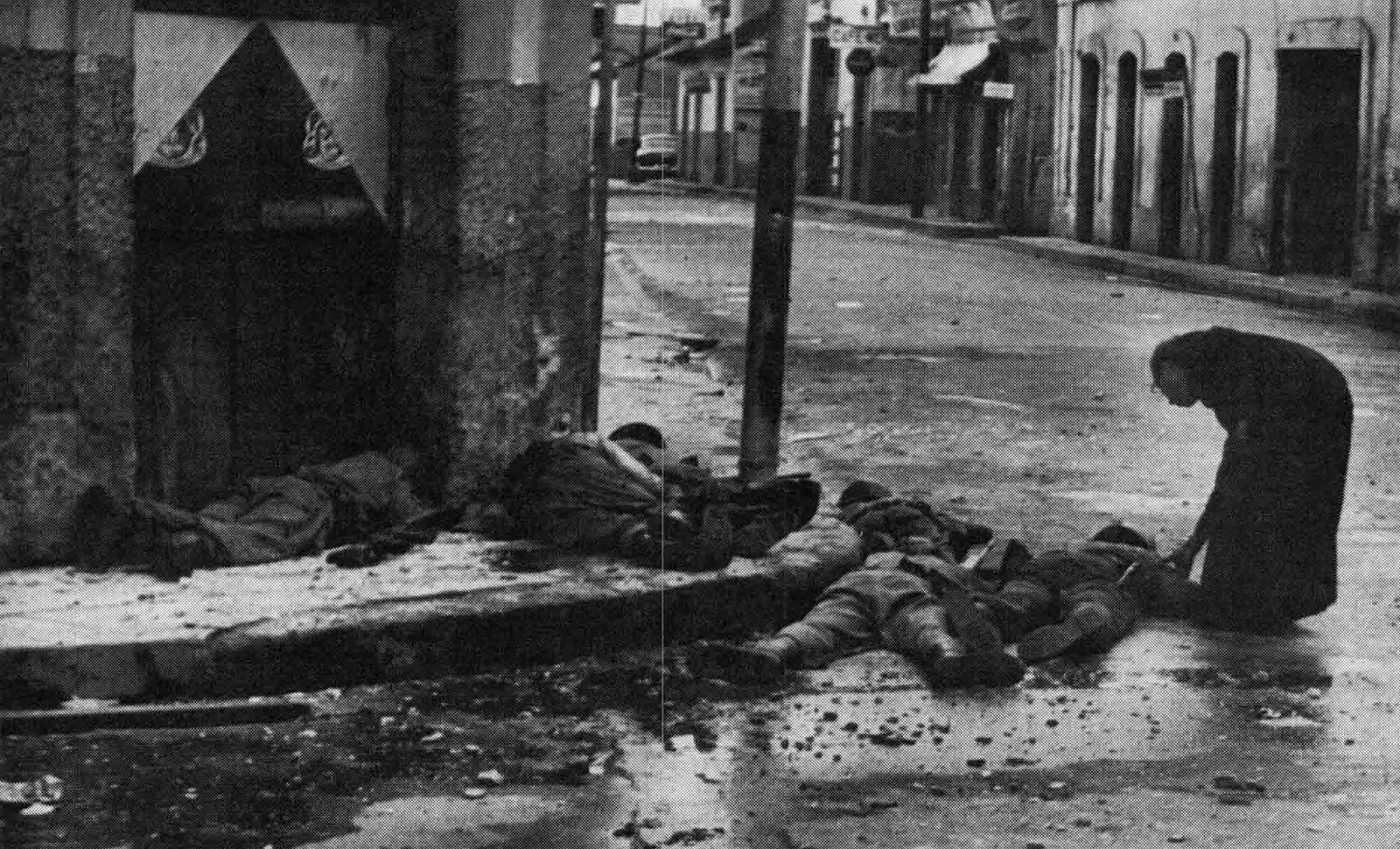
Luis Padilla had no fear of catching a bullet. He just walked around, giving the last rites to dying soldiers. And Hector Rondon Lovera followed him, capturing his historical pictures.
The historical aspect of ‘The priest and the dying soldier.’
In early May 1962, local communists in Venezuela upraised to overthrow the current regime of President Romulo Betancourt. The president didn’t show any sign of fear or weakness. Betancourt passed through the hardening prison and fierce political struggle, so he perfectly knew hot to stand a blow. He refused to negotiate with rebellious military garrisons, demonstrators, and protesters. The Communist Party and the Revolutionary Left organizations became illegal. President Betancourt sent loyal troops to the cities where communist propaganda reached its peak. Puerto Cabello (population 150,000) was on the list of rebellious cities. Some of the bloodiest street battles in the history of the Venezuelan uprising of 1962 took place here. That was a time for the legendary photograph ‘The priest and the dying soldier’ that won the Pulitzer Prize a year later.
The uprising failed pretty quickly. President Rómulo Betancourt was strong enough to suppress the insurgents. Byt Hector Rondon captured the historical pictures.
A real Aid from Padre
The priest in this photo is Luis Padillo. He was a real hero, and an honest priest, who didn’t support any of the parties. Padillo did not try to look for the right and the wrong. He went out into the street to help the wounded, no matter which camp they belonged to. The massive fire could end up his mission any second. Both sides didn’t care about the number of bullets to fire, hundreds of casualties laid on the battlefield.
All the killed and wounded for the priest of the church were the children of Christ. Padre Padillo, without any fear, performed his professional duty and also helped the injured get out of the fire and get to the shelter. The churchman remained in office until the very end of the uprising. Noteworthy, that South Americans, communists, and their opponents, are extremely religious people. Of course, they tried not to shoot a priest as hard as they could. However, a stray bullet does not spare anyone, so Aid from Padre was the highest act of service to humanity. And Luis Padillo will forever remain in history as a symbol of humanism.

On June 2, 1962, units led by navy Captains Manuel Ponte Rodríguez, Pedro Medina Silva, and Víctor Hugo Morales went into rebellion.
There’s a building with a carnicería sign behind the priest and dying soldier. In Spanish, this word has two meanings: “butcher’s shop” and “Carnage.” There are no better words for those days of history. The Aid from Padre photo became popular immediately. Interestingly, the leaders of the rebels said that the picture aimed at discrediting their movement. They stated that Hector Rondon Lovera staged it. However, this statement contradicts other photos of Lovera, that show how the priest continues to treat the wounded.
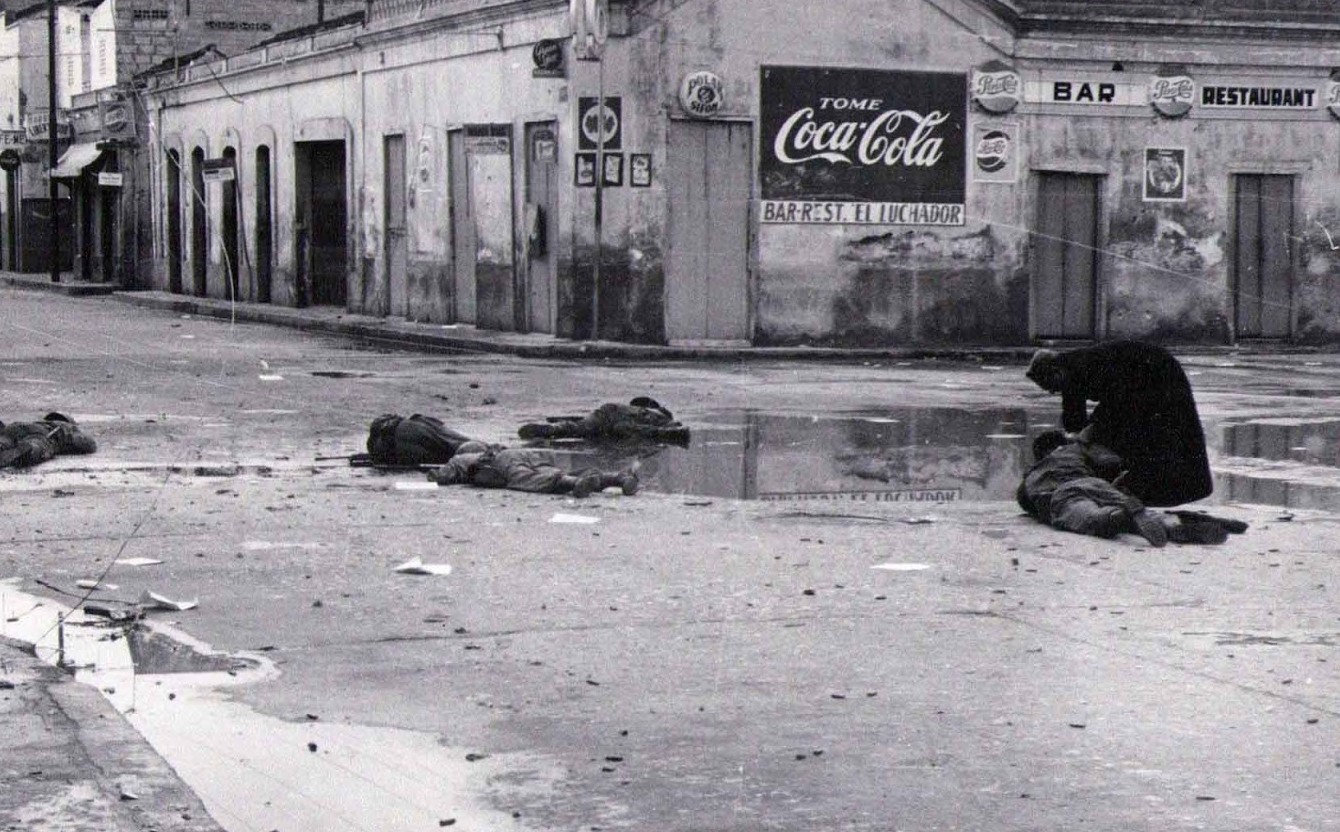
Luis Padillo will forever remain in history as a symbol of humanism.
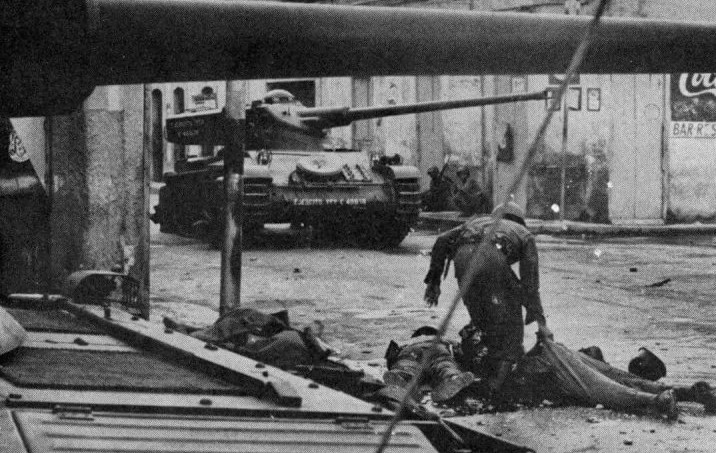
Another shot from the ‘Aid from Padre’ series shows: none of the pictures were staged.
Сообщение Pulitzer photography: The priest and the dying soldier, 1962 появились сначала на Old Pictures.
]]>Сообщение Pulitzer prize photo: Baby Jessica, 1987 появились сначала на Old Pictures.
]]>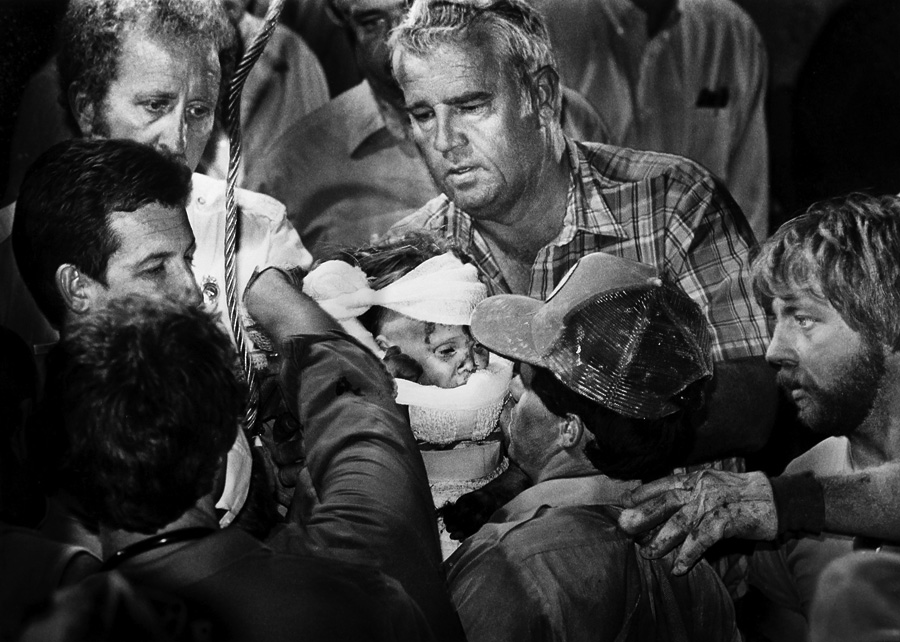 With this photo of Baby Jessica, Oldpics starts a new section of Pulitzer Prize-winning pictures. We aim to highlight the most excellent images in the history of this prestigious award, adding some noteworthy facts and stories behind.
With this photo of Baby Jessica, Oldpics starts a new section of Pulitzer Prize-winning pictures. We aim to highlight the most excellent images in the history of this prestigious award, adding some noteworthy facts and stories behind.
Oldpics had already covered some of the Pulitzer-winning photos before while covering the Top 100 most influential photos in history. ‘Saigon Execution’ by Eddie Adams and ‘The Allende Last Stand’ are the most excellent examples. But there’s plenty of other outstanding images that Pulitzer jury selected during the decades of their work.
How Pulitzer photo award appeared.
The Pulitzer Prize has a long, more than 100 years of history. It was established by the world-famous newspaper publisher Joseph Pulitzer. His breakthrough publications New York World and St. Louis Post-Dispatch, reinvented newspaper journalism. Pulitzer implemented a lot of innovation in the publishing business, including the university level of journalistic education.
Joseph Pulitzer defined “four awards in journalism, four in drama, one in education, and four traveling scholarships.” Nowadays, the jury announces winners of the Pulitzer award each April annually. Although, the first winner received his prize on June 4, 1917.
The story of ‘Baby Jessica’ photo
Scott Shaw captured this picture 33 years ago, at the end of the 58-hour baby-saving campaign. There were numerous cameramen from the top publications, CNN was covering the incident non-stop. But Scott Shaw had the luckiest angle and the best moment so that his ‘Baby Jessica’ photo won Pulitzer prize that year.
This photo was the final accord during the saving of 18-month-old Jessica McClure, who fell down an 8-inch-diameter well shaft in Midland, Texas. Reporters named her “Baby Jessica.”
The rescue force had almost no time to act. But the rock in the ground and the lack of necessary equipment complicated matters. The ultimate strategy to penetrate a shaft next to the well and then a tunnel to her location ended up taking until Oct. 16 to accomplish. Press reported that Baby Jessica was singing “Winnie the Pooh” songs from time to time, confirming worried bystanders she was still breathing.
In the end, of course, paramedic Robert O’Donnell of the Midland Fire Department saved Baby Jessica. He passed through the tunnel, picked McClure from the well, and handed her to assistant paramedic Steve Forbes.
This photo reminds us of one of the most excellent pictures by Eugene Smith: ‘Soldier holding a baby.’ Luckily, the Japanese bombs were not exploding while Baby Jessica saving campaign.
Сообщение Pulitzer prize photo: Baby Jessica, 1987 появились сначала на Old Pictures.
]]>